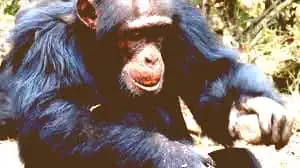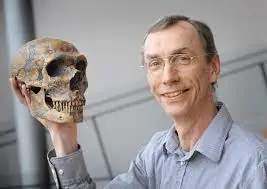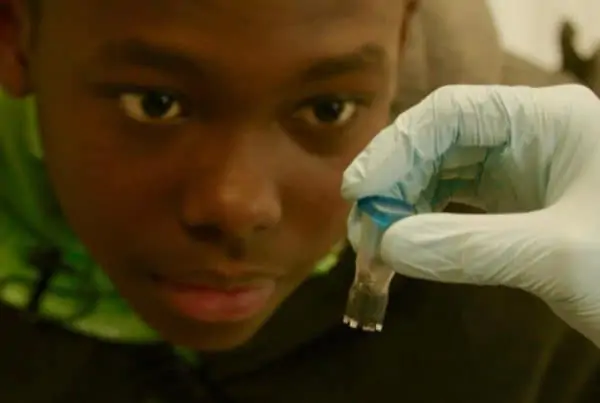African gene alleles closer genetically to archaic hominins and non-human primates?
Africans such as the Khoe-San tribe of southwest Africa may be closer to non-human primates says a well-known geneticist. Geneticists have found that Khoe-San diverged from other early modern Homo sapiens 170,000 years ago. African Pygmies are said to have diverged 130,000 years ago.
 Dr. Shi Huang (Google Scholar) is a former Professor of Epigenetics and Evolution, Central South University, (Burnham Institute, UCSD). Univ. of California San Diego of course, is well known for producing the popular series of human evolution lectures on YouTube. Dr. Huang is now affiliated with the Central South University – CSU · Center for Medical Genetics in China.
Dr. Shi Huang (Google Scholar) is a former Professor of Epigenetics and Evolution, Central South University, (Burnham Institute, UCSD). Univ. of California San Diego of course, is well known for producing the popular series of human evolution lectures on YouTube. Dr. Huang is now affiliated with the Central South University – CSU · Center for Medical Genetics in China.
During his early career at the Pew Institute, Dr. Huang [was] “studying the relationship between genetic diversity and epigenetic complexity and its role in common diseases and evolution… We proposed a novel hypothesis of genetic diversity and evolution, the Maximum Genetic Diversity (MGD) hypothesis… Genetic diversity of a species has an upper limit as set up by the epigenetic complexity levels…”
“Africans carry more ancestral alleles”
On Nov. 26, 2020 Shi Huang Tweeted:
 “That Africans carry more ancestral alleles (=archaic or apes) has been well demonstrated by the rooting of phylogenetic trees in Africa for both autosomes and uniparental DNAs by using the outgroup rooting method. Biological significance of this? Eerie silence…”
“That Africans carry more ancestral alleles (=archaic or apes) has been well demonstrated by the rooting of phylogenetic trees in Africa for both autosomes and uniparental DNAs by using the outgroup rooting method. Biological significance of this? Eerie silence…”
In 2011 a research team tackled the precise question of African admixture with archaic hominids.
Michael Hammer (bio) is the Director of the University of Arizona Genetics Core (UAGC) and co-director of the UACC Genomics Shared Resource. He has joint appointments in Departments of Neurology and Ecology and Evolutionary Biology.
Also Dr. Jeff Wall, Professor of Epidemiology and Biostatistics (bio) Recent studies have focused on the contribution of archaic hominid ancestry in human populations.
African Admixture from Homo naledi or Australopithecines?
Their findings (PNAS.org, Genetic Evidence for Archaic Admixture in Africans):
 Here we use DNA sequence data gathered from 61 noncoding autosomal regions in a sample of three sub-Saharan African populations (Mandenka, Biaka, and San) to test models of African archaic admixture.
Here we use DNA sequence data gathered from 61 noncoding autosomal regions in a sample of three sub-Saharan African populations (Mandenka, Biaka, and San) to test models of African archaic admixture.
We use two complementary approximate-likelihood approaches and a model of human evolution that involves recent population structure, with and without gene flow from an archaic population.
Extensive simulation results reject the null model of no admixture and allow us to infer that contemporary African populations contain a small proportion of genetic material (≈2%) that introgressed ≈35 kya from an archaic population that split from the ancestors of anatomically modern humans ≈700 kya. [Emphasis added]
Hawks (lecture, 2017):
“We do know that African populations derive some small fraction of their DNA, possibly as much as 5%… from archaic lineages that we haven’t discovered… What we don’t know is the identity of that lineage… It could be Naledi?”
Svante Pääbo on a possible archaic mix (lecture, 2018):
 “There’s some indications of that in the genomes of present day Africans.”
“There’s some indications of that in the genomes of present day Africans.”
And most recently, 2019, Arun Durvasula and Sriram Sankararaman from the University of California in Los Angeles confirmed up to 19% archaic Hominid DNA in modern Africans. They have described the ancestor as a “ghost species” or quite possibly Homo naledi a “small-brained hominin” on the “African plains 250,000 years ago.” (IFL Science)
But as Professor Shi Huang implies, as the answer to the puzzle gets closer to being solved, an “eerie silence” has overtaken the paleontology, genetics and anthropology communities.
Suggesting Africans closer to Chimpanzees “a sensitive topic”
Shi Huang received international media for that Tweet. But he has also been a guest on a number of alt-media since such as Edward Dutton’s Jolly Heretic show on YouTube. He has been asked about his previous statements regarding the genetic connection to Chimpanzees from Africans and he has not backed away.
Now, Dr. Huang is doubling down on his previous statements. On February 21, 2024 he Tweeted out the following:
Some racial groups such as Khoe-San carry more ancestral alleles (AAF: AA freq), i.e. chimpanzee alleles, and hence less modern than other people in whom the derived alleles are fixed. This makes sense with known traits. But it is a sensitive topic.
Dr. Huang was responding to a just released paper by Svante Pääbo , Hugo Zegberg and Matthias Jacobsen,
The genetic changes that shaped Neandertals, Denisovans, and modern humans
From the Abstract Science Direct:
Modern human ancestors diverged from the ancestors of Neandertals and Denisovans about 600,000 years ago. Until about 40,000 years ago, these three groups existed in parallel, occasionally met, and exchanged genes. A critical question is why modern humans, and not the other two groups, survived, became numerous, and developed complex cultures. Here, we discuss genetic differences among the groups and some of their functional consequences. As more present-day genome sequences become available from diverse groups, we predict that very few, if any, differences will distinguish all modern humans from all Neandertals and Denisovans. We propose that the genetic basis of what constitutes a modern human is best thought of as a combination of genetic features, where perhaps none of them is present in each and every present-day individual.



